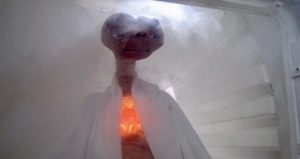E.T. the Extra-Terrestrial (1982). Directed by Steven Spielberg, Written by Melissa Mathison. Music by John Williams. Staring Henry Thomas, Drew Barrymore, and Peter Coyote. 115 mins. Rated PG.
Lest there be any doubt about exactly where that blockbuster E.T. The Extraterrestrial was headed the one shot suddenly, and indisputably, makes that all clear, and—surprise–what you thought you were seeing, well, that was not it at all. And this is the sort of surprise that movies rarely pull off or, for that matter, ever attempt, which is much the same sort of blindness that humans carry around with them, no matter how much they’ve heard otherwise. And that surprise is one of the biggest in all of film history—and, for that matter, all of human history.
So a lonely, heartbroken boy, Elliott, all of ten or twelve years old, stumbles upon a similarly bereft and needy creature, a rather funny-looking alien from only-God-knows-where. Elliott’s father has run off with his secretary, and the alien’s friends have left him behind lest they be captured by marauding American scientists. Neither of these two is very formidable, to say the least, for they are indeed among the least of these—both exiled and also alien, albeit in different ways. Well, they need each other, big-time, and fast friends they become, first out of necessity and then from within a deep well of love, given what they do for each other. And then, too, there is also the creature’s ability to actually inhabit another’s mind, a kind of co-indwelling, a condition that makes for both high comedy and wrenching tenderness. Mid-way through, as the alien lies dying on a gurney in a lab, because earth’s atmosphere is not so good for aliens (and ever less so for humans too), Elliot himself also begins to die, that most aching of all human words.
Until, that is, the creature, named ET by Elliott for extra-terrestrial (the name, appropriately, begins and ends with the first and last letters of Elliott’s own name) severs his tie with Elliott in a gesture of supreme love, for without Elliott’s “life” he cannot live, “withdrawing” himself from Elliott so Elliott might live. In this symbolic and symbiotic co-indwelling, the pair sustain one another. While not the usual rendering of pneumatology, it offers a fresh spin of what it should maybe look like. And while viewers watch and wonder and even weep at this, as I did back when, we don’t really get it, at least not yet, meaning the full shebang of the story the film tells.
In order to dispel any mental “fuzz” about what’s going on here, it all comes rather clear, shockingly so, as if suddenly slapped in the face. Though skeptical of his plan, Elliot’s mates make off with the government van holding the remains of supposedly demised ET. With the Feds in hot pursuit, they come to a stop in park, and there they dispute just why they’re doing this wild stunt. And at that moment, so to answer all their perplexities and fears, the rear doors swing open, clouds of white smoke (dry ice) billowing out, and through the fog steps a majestic looking ET, draped as he is with a white death cloth over his body, risen and resplendent, his warm red heart aglow once again.

The image borrows from Christian pop art of Jesus emerging from the tomb, grave-cloth over his head amid a cloud of white smoke or whatever. It is, in fact, the climactic moment, the pivot, showing viewers what love can do and that all will be well.
And, lo, all the noisy boys fall dead silent at the sight of the suddenly revivified ET, now majestic and luminous. Sometimes even the movies have actual icons, and this shot makes one of cinema’s most “telling,” not only explaining but radically overturning audience expectations of what is reasonable and smart. And for this there are hardly words, “it” simply being “it.” The lowly exile and fugitive, neither attractive nor powerful (or so it seems), a being who has brought love and hope to the forsaken (Elliott). Though hunted and dead, he is alive again and shows forth, now transfigured, masterful, regal, and luminous. He has made the “christomorphic” journey, moving from forsaken outcast to he who makes the world into what it was intended to be in the first place. It is, indeed, in Frederick’s Buechner’s words, the story “too good not to be true.”
written by Roy Anker
Sign Up for Our Newsletter!
Insights on preaching and sermon ideas, straight to your inbox. Delivered Weekly!
Categorized into Resurrection
E.T. the Extra Terrestrial (1982) – 3